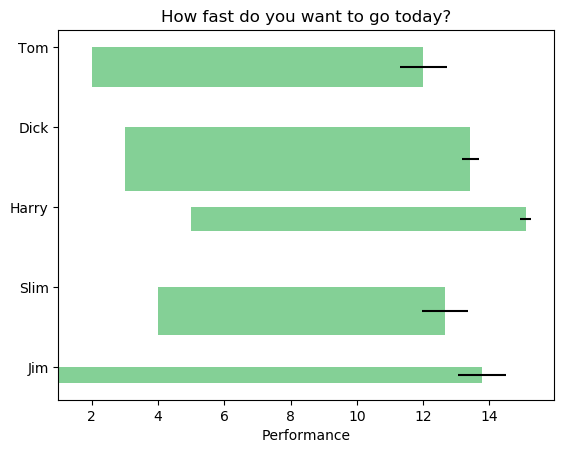This example showcases a simple horizontal bar chart
import matplotlib.pyplot as plt
import numpy as np
# Fixing random state for reproducibility
np.random.seed(19680801)
plt.rcdefaults()
fig, ax = plt.subplots()
# Example data
people = ('Tom', 'Dick', 'Harry', 'Slim', 'Jim')
y_pos = np.arange(len(people))
performance = 3 + 10 * np.random.rand(len(people))
error = np.random.rand(len(people))
ax.barh(y_pos, performance, xerr=error, align='center')
ax.set_yticks(y_pos)
ax.set_yticklabels(people)
ax.invert_yaxis() # labels read top-to-bottom
ax.set_xlabel('Performance')
ax.set_title('How fast do you want to go today?')
plt.show()
np.random.seed()
使用seed(value)之后调用np.random.randn()或np.random.rand()可以产生固定的随机值
# 使用seed设置随机种子
np.random.seed(19680801)
print(np.random.randn(2,5), end='\n\n')
# 不设置随机种子
print(np.random.randn(2,5), end='\n\n')
# 设置相同的随机种子
np.random.seed(19680801)
print(np.random.randn(2,5))[[ 1.04930431 0.86609917 0.5511346 1.72807779 -0.64928812]
[-0.47841958 1.07788511 0.96881033 -0.80934479 -1.2373891 ]]
[[ 1.86011654 -0.30831924 0.78297055 0.02152345 0.71566379]
[ 1.40146651 -1.12750212 1.65581822 1.40096148 0.20199007]]
[[ 1.04930431 0.86609917 0.5511346 1.72807779 -0.64928812]
[-0.47841958 1.07788511 0.96881033 -0.80934479 -1.2373891 ]]plt.rcdefaults()
- matplotlib配置信息是从配置文件中读取的。在配置文件中可以为matplotlib几乎所有的属性指定永久有效的默认值
- 查看配置:你可以通过 matplotlib.rcParams字典访问所有已经加载的配置项
- 可以通过
matplotlib.rcParams字典修改所有已经加载的配置项 - 可以通过
matplotlib.rc(*args,**kwargs)来修改配置项,其中args是你要修改的属性,kwargs是属性的关键字属性 - 可以调用
matplotlib.rcdefaults()将所有配置重置为标准设置
import matplotlib
print(matplotlib.rcParams['animation.embed_limit'])
matplotlib.rcParams['animation.embed_limit'] = 10
print(matplotlib.rcParams['animation.embed_limit'])
matplotlib.rc('animation', embed_limit=15)
print(matplotlib.rcParams['animation.embed_limit'])
matplotlib.rcdefaults()
print(matplotlib.rcParams['animation.embed_limit'])20.0
10.0
15.0
20.0pyplot.barh()
- barh(y, width, height=0.8, left=None, *, align='center', **kwargs)
| Parameters | Meaning |
|---|---|
| y(标量或向量) | 每个bar的y坐标 |
| width(标量或向量) | 每个bar的宽度 |
| height | 每个bar的高度 |
| left(向量) | bar左侧基坐标 |
| align | 可以是'center'或'edge',表示bar和y轴ticks之间的位置关系 |
# Fixing random state for reproducibility
np.random.seed(19680801)
# plt.rcdefaults()
fig, ax = plt.subplots()
# Example data
people = ('Tom', 'Dick', 'Harry', 'Slim', 'Jim')
y_pos = np.arange(len(people))
performance = 3 + 10 * np.random.rand(len(people))
error = np.random.rand(len(people))
#使用height和left控制bar的宽度和左侧坐标,color设置bar的颜色,align设置bar和ytick的对齐方式
ax.barh(y_pos, performance, [0.5, 0.8, 0.3, 0.6, 0.2], [2, 3, 5, 4, 1],
xerr=error, align='edge', color="#84D096")
ax.set_yticks(y_pos)
ax.set_yticklabels(people)
ax.invert_yaxis() # labels read top-to-bottom
ax.set_xlabel('Performance')
ax.set_title('How fast do you want to go today?')
plt.show()